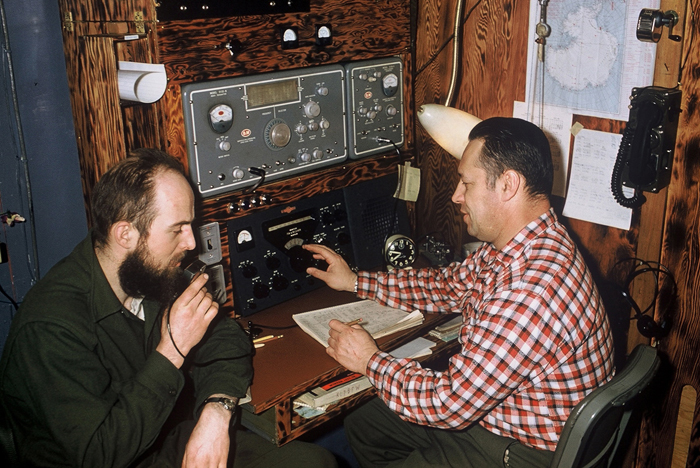|
Into the unknownLearning celestial navigation wasn’t easy, even for a group of Ph.D.s, particularly in the cold of winter. In the summer, they practiced using the sun as a navigational guide. Finally, in November 1957, they rumbled away from Byrd Station to the interior of Marie Byrd Land. “We never had much sense of danger. We never were in much danger,” Bentley insists. He believed at the time that they would encounter few, if any, crevasses. If they did encounter one, they would simply turn in another direction. The strategy worked. “[We] only found one crevasse when we started to drive up on the side of the mountain, which is something we weren’t supposed to be doing anyway,” he says ruefully. It only worked, he admits, because the team drove east rather than west — zigged instead of zagged — where ice streams riddled with crevasses awaited them. “We lucked out, and went in the crevasse-free direction,” he adds. As the expedition’s seismologist, Bentley took charge of measuring the underlying snow and ice. The process involved unrolling hundreds of meters of cable outfitted with geophones (a sort of motion detector) and setting off explosives that sent sound waves down to the base of the ice sheet below. In this way, they were able to measure the ice thickness and the depths of reflecting layers within the ice. Surprises also awaited the team above the snow — a group of mountains had appeared on the horizon. Bentley says the team believed they saw just a few small peaks, and each morning expected to reach the outcrop of hills. “This went on for a couple of weeks,” Bentley says. “We saw this great spread of mountains that was totally uncharted. As far as we could tell, we were the first people to see these mountains. … It was spectacular.” Mount Bentley, at 4,274 meters, in what is now called the Ellsworth Mountains, bears his name. Old and new scienceUnsure if he would ever return to the continent — the IGY was to end in 1959 — Bentley volunteered to stay a second winter at Byrd and led another traverse during the 1958-59 austral summer. But it turned out the United States was in Antarctica to stay, and so was Bentley. He worked on several more such traverses around the South Pole until the NSF canceled the program in the 1960s. He made his most recent visit to the continent in the mid-1990s. Bentley credits Paul Mayewski, director of the Climate Change Institute at the University of Maine, for reviving the overland traverse in the modern era. A principal investigator for the International Trans-Antarctic Scientific Expedition (ITASE), Mayewski completed the final leg of a trip to the South Pole on Christmas Eve 2007. The traverse collected data that will help the multi-national program reconstruct the continent’s climate over the last 200 to 1,000 years. (See related story on ITASE 2006-07: Scientists traverse East Antarctica for ice cores.) Mayewski met Bentley during the Greenland Ice Sheet Project 2 (GISP2) in the early 1990s. At the time, GISP2 recovered the longest ice core in the world, at just over 3,000 meters. The younger scientist, who has trekked across much of the continent by foot, ski and tracked vehicle since 1968, credits Bentley and the exploits of his contemporaries for helping inspire his own career. “When I was a kid, I read about Charlie’s work in National Geographic, and was certainly inspired,” Mayewski says. “I was always very interested in remote places, and Antarctica always fascinated me, and [the IGY era] certainly had something to do with my interest in Antarctica and other remote places.” Today kids are reading about the work polar scientists like Mayewski are doing for the International Polar Year (IPY), a multi-national science campaign much like the IGY, but focusing on the Arctic and Antarctic in the context of climate change. Bentley sees parallels and differences between the two eras. Most striking, he says, is that 50 years ago the researchers were busy with discovery and description. Now, scientists study processes and dynamics, such as measuring how fast a glacier is moving. “We had no way of measuring it,” he explains. “You’re standing on an ice sheet, [but] you have no idea. It’s not moving fast enough so that you get the wind in your face.” Back to school?The veteran polar scientist is eager to feel the Antarctic wind once again on his face. But before he heads into the field, he must take an overnight outdoor course required of anyone working in the field. Not even Charles Bentley can play hooky from Happy Camper School. “So, after 50 years, I have to learn how to survive in Antarctica,” he says, with a shrug. “I’m just going to have a good time.” Editor’s Note: Not to worry. Bentley made it to WAIS Divide despite the weather delays, and even spent a couple of extra, unexpected days there. He hopes to be back after he turns 80 to witness the final season of the WAIS deep-core project. |



For USAP Participants |
For The Public |
For Researchers and EducatorsContact UsNational Science FoundationOffice of Polar Programs Geosciences Directorate 2415 Eisenhower Avenue, Suite W7100 Alexandria, VA 22314 Sign up for the NSF Office of Polar Programs newsletter and events. Feedback Form |


